20061104 - Photo essay of practice run
Session name: 20061104.1015
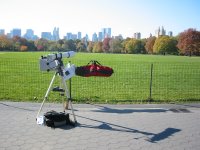 Just setup and ready to go.
Just setup and ready to go.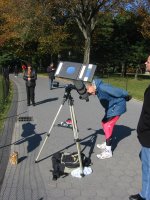 "May have a look?" "What am I supposed to be looking at?" "You mean that's not dirt on the lens?" Probably the 3 most frequently asked questions.
"May have a look?" "What am I supposed to be looking at?" "You mean that's not dirt on the lens?" Probably the 3 most frequently asked questions.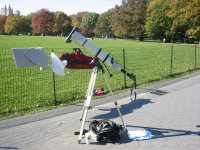 Coolpix 995 attached to the straight through connector on the Tak.
Coolpix 995 attached to the straight through connector on the Tak.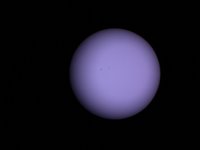 Shot the whole soalr disk without telephoto magnification and the vignetting is obvious.
Shot the whole soalr disk without telephoto magnification and the vignetting is obvious.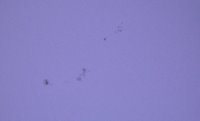 With or without magnification groups 921 & 922 were obvious. Seeing was not steady some moments were crystal, sharp while mostly other times it was slightly soft.
With or without magnification groups 921 & 922 were obvious. Seeing was not steady some moments were crystal, sharp while mostly other times it was slightly soft.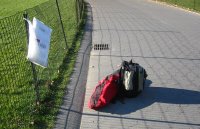 This is my Tak observing kit packed up at the end of the session.
This is my Tak observing kit packed up at the end of the session.Notes.
Just bought a used Nikon Coolpix 995 to shoot the Mercury transit this coming Wednesday and then have a handy photography kit on hand for lunar observing sessions. This camera is a dinosaur, sounds like a brontosaurus, and is as fast as a 16MHz 68030 processor (MAC SE/30 :^D). It's not as easy as I thought it would be because focus is difficult on these little LCD displays, the user control that one can exploit is beyond me at this time.
Since I was practicing during the day at TotL maybe 75 ~ 100 persons stopped by. There were many I suspect not from New York because of their brogues, heavy accents, and some non-English. Tomorrow is the NYC marathon so there are a lot of folk in from the outside. It worked out well because I got a couple of hours in shooting Sun. Hopefully I'll be comfortable with the camera and setup by the time of Mercury transit.
One thing I've noted about showing Sun to the public is that they really don't know what they're looking at or looking for. I think that is normal because most haven't looked through a telescope and don't have any other experience to relate it to. Typically, I like to keep a low power view where the entire disk is observed. When people approach I suggest that they look at the sun "naked-eye" through the viewing window; in other words, without any optical aid but through the solar filter, as shown here. The scope looks through a hole that has Baader solar film and the other rectangular cutout is what I am calling the viewing widow. They look from the scope side.


I ask that they look for Sun in the viewing window so they have a context to refer to and have a little experience with the filtered view. This allows them to recognize the solar disk and then see the sunspots in the eyepiece. Most that ignore the suggestion and rush to get into the eyepiece don't know what they are looking at and think that the big white disk is light of the telescope and don't see anything else.
It's all okay. I pull out my trusty Moleskine notebook which I made a couple of sketches and show them what they see. It's funny that many return to viewing window to look at the solar disk "unaided" and affirm their understanding.
I like the Tak for these solar system sessions and it is ideal for the little kids. To accommodate all sizes of passersby a quick twist of the diagonal puts the eyepiece in the right place. Kids two and half feet tall can observe as easy as the adults.
<< Home